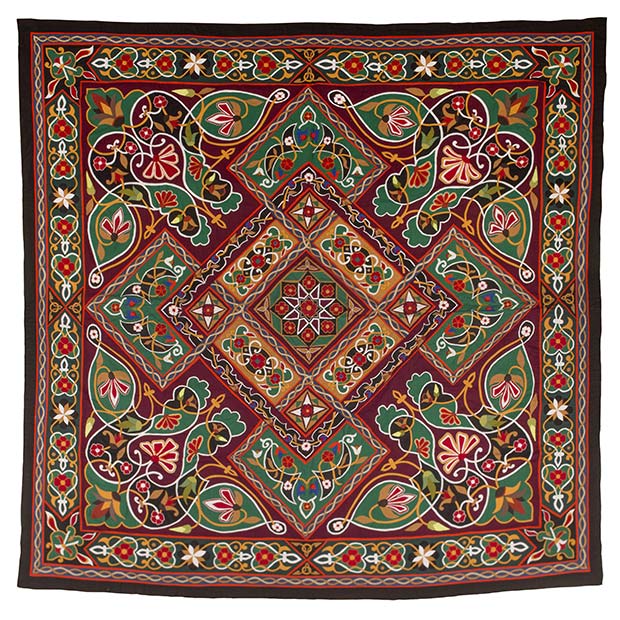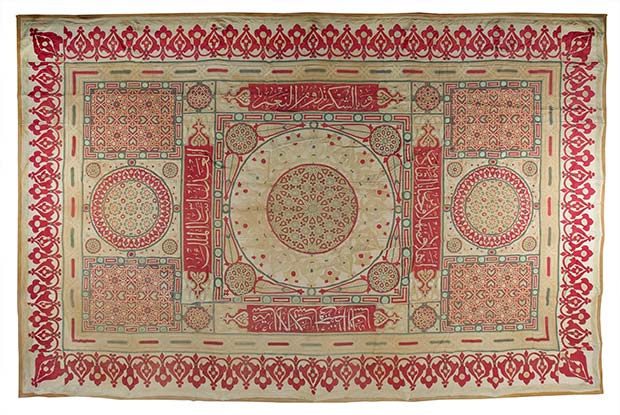
Exhibition at the Islamic Arts Museum Malaysia (IAMM), Kuala Lumpur (Oct 2, 2015 - Jan 31, 2016) ‘Khayamiya: Khedival to Contemporary’, The Tentmakers of Cairo
Sep 23, 2015 Art Collection

 The Syme Panel, Cotton-appliquéd tent panel, Circa 1890-1910 AD. The first Khedival khayamiya to be discovered in Australia / Photo by Timothy Crutchett / Courtesy of IAMM
The Syme Panel, Cotton-appliquéd tent panel, Circa 1890-1910 AD. The first Khedival khayamiya to be discovered in Australia / Photo by Timothy Crutchett / Courtesy of IAMM
Khayamiya is the Egyptian art of tent-making. Bright fabric pieces are cut, folded and skillfully handsewn to large canvases to create impressive tents and textile panels. These textiles are used in many Egyptian ceremonies, including weddings, funerals, street parties and religious events.
 A ‘Neo-Khedival’ by Ahmed Naguib, 2012, based an example acquired by Doris Duke. After seeing a photograph of a Khedival khayamiya in the private collection of Doris Duke, Ahmed Naguib recreated the century-old textile using modern fabrics / Photo by Timothy Crutchett / Courtesy of IAMM
A ‘Neo-Khedival’ by Ahmed Naguib, 2012, based an example acquired by Doris Duke. After seeing a photograph of a Khedival khayamiya in the private collection of Doris Duke, Ahmed Naguib recreated the century-old textile using modern fabrics / Photo by Timothy Crutchett / Courtesy of IAMM
 Ahmed Naguib’s 'Syrian Ceiling', Cotton-appliquéd tent panel, 2012 AD. Ahmed Naguib designed this contemporary khayamiya after seeing a photograph of an ajami room from a Syrian house / Photo by Timothy Cructhett / Courtesy of IAMM
Ahmed Naguib’s 'Syrian Ceiling', Cotton-appliquéd tent panel, 2012 AD. Ahmed Naguib designed this contemporary khayamiya after seeing a photograph of an ajami room from a Syrian house / Photo by Timothy Cructhett / Courtesy of IAMM
This exhibition will take visitors on a journey through the spectacular transformations of khayamiya from the late Ottoman Empire up to the present day. Some of the highlights featured in this exhibition include the first Khedival khayamiya to be discovered in Australia (the Syme Panel), and rarely-seen monumental tent panels from the world-leading Bowker Collection. Furthermore, the IAMM will be displaying one of its most treasured objects, a complete 19th-century Ceremonial Egyptian Tent, to demonstrate khayamiya’s status as a sophisticated textile art form with a rich legacy of Islamic design influences.
 Egyptian ceremonial tent, Cotton-appliquéd tent, Circa 1900 AD / 1317 AH. A complete Egyptian ceremonial tent displayed at the centre of the exhibition to demonstrate the sophisticated art of khayamiya / Courtesy of IAMM
Egyptian ceremonial tent, Cotton-appliquéd tent, Circa 1900 AD / 1317 AH. A complete Egyptian ceremonial tent displayed at the centre of the exhibition to demonstrate the sophisticated art of khayamiya / Courtesy of IAMM
 The Garden Panel, Cotton-appliquéd tent panel, Circa 1960-1970 AD. Abstract floral patterns like this were common in the Fatimid period, over a thousand years ago / Courtesy of IAMM
The Garden Panel, Cotton-appliquéd tent panel, Circa 1960-1970 AD. Abstract floral patterns like this were common in the Fatimid period, over a thousand years ago / Courtesy of IAMM
Today, khayamiya is mainly produced along the historic Street of the Tentmakers in Cairo, Egypt. Hundreds of men worked in this industry for centuries, but due to changing technologies, very few tentmakers now remain. “We aim to raise international awareness of khayamiya by recognizing the work of the Egyptian tentmakers as skilled craftsmen and artists,†said Dr Bowker. “This important exhibition helps the tentmakers of Cairo by sharing their stories and skills with new audiences, and by displaying khayamiya as one of the most vibrant and authentic forms of Egyptian art.â€
 Two Columns by Ekramy Hanafy, 2014. This design looks to the future of khayamiya as contemporary Egyptian art. Contemporary Khayamiya Bowker Collection / Photo by Timothy Crutchett / Courtesy of IAMM
Two Columns by Ekramy Hanafy, 2014. This design looks to the future of khayamiya as contemporary Egyptian art. Contemporary Khayamiya Bowker Collection / Photo by Timothy Crutchett / Courtesy of IAMM
 The Thatcher Panel, Cotton-appliquéd tent panel, Circa 1900-1910 AD. The Thatcher panel is named for Ada L. Thatcher Huntzinger, who acquired it while travelling in Cairo in the early 1900s / Photo by Timothy Crutchett / Courtesy of IAMM
The Thatcher Panel, Cotton-appliquéd tent panel, Circa 1900-1910 AD. The Thatcher panel is named for Ada L. Thatcher Huntzinger, who acquired it while travelling in Cairo in the early 1900s / Photo by Timothy Crutchett / Courtesy of IAMM
Dr. Sam Bowker will be hosting a public talk on Saturday, October 3, 2015, at 10.30 am followed by a lecturing tour of the exhibition. His book, 'Khayamiya: The Art of Egyptian Tentmakers', will be published in 2016. The exhibition will also be organising educational programmes such as appliqué workshops, story-telling session, exciting competition and many more!
'Khayamiya: Khedival to Contemporary' exhibition will be on display at Special Gallery 1 of the Islamic Arts Museum Malaysia from October 2, 2015 until January 31, 2016.
 Panel from a Suradeq, Circa 1970-2000 AD. Enormous pavilions called Suradeq are used across Egypt to host celebrations like weddings, feasts, graduations and funerals / Photo by Timothy Crutchett / Courtesy of IAMM
Panel from a Suradeq, Circa 1970-2000 AD. Enormous pavilions called Suradeq are used across Egypt to host celebrations like weddings, feasts, graduations and funerals / Photo by Timothy Crutchett / Courtesy of IAMM
 The Rhode Island Panel, Circa 1900-1920 AD. This large ‘ceiling’ khayamiya was collected by American travellers in the early 20th century / Photo by Timothy Crutchett / Courtesy of IAMM
The Rhode Island Panel, Circa 1900-1920 AD. This large ‘ceiling’ khayamiya was collected by American travellers in the early 20th century / Photo by Timothy Crutchett / Courtesy of IAMM
The Islamic Arts Museum Malaysia is a non-profit organisation dedicated to being a custodian, preserver and educator of Islamic art. It is located at Jalan Lembah Perdana, 50480 Kuala Lumpur, neighbouring the National Mosque and Islamic Centre. It is within walking distance of the National Museum, National Planetarium, Orchid Garden, Butterfly Park and Bird Park. Opening hours are from 10.00am to 6.00pm, daily. The 12 permanent galleries in the museum comprise: Architecture, Qur’ans & Manuscripts, India, China, Malay World, Textiles, Jewellery, Arms & Armour, Coins, Metalwork, Ceramic & Glass and Living with Wood.
Comments
Add a comment